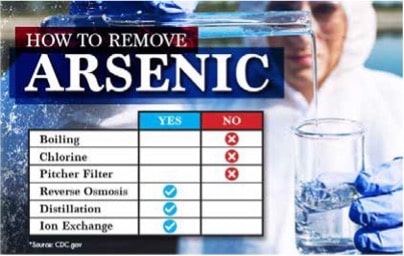Arsenic In Escondido Water: Should You Be Concerned?
The U.S. Geological Survey (USGS) and Centers for Disease Control and Prevention estimate about 2.1 million people in the U.S. may be getting their drinking water with high concentrations of arsenic. While arsenic naturally occurs in nature, high levels can be a cause for worry, especially when it comes to the drinking water you consume.
How to Remove Arsenic From Your Escondido Water
Culligan offers a range of products that can effectively remove arsenic from water. Some of the popular options include reverse osmosis systems, specialized arsenic filters, and whole-house water filtration systems. These systems are designed to reduce or eliminate arsenic, ensuring that your water is safe and clean to drink. It’s important to note that the specific product recommendation may vary based on your water quality and requirements. To get the best solution for your needs, schedule an appointment with us! One of our Culligan Water experts can assess your situation and provide personalized recommendations.
How Can Arsenic 3 and Arsenic 5 Effect Your Drinking Water?
Arsenic comes in two common oxidation states: arsenic 3 (also known as arsenite) and arsenic 5 (also known as arsenate). The main difference between the two lies in their chemical structures and properties.
Arsenic 3 is a reduced form of arsenic and is typically more toxic and soluble in water compared to arsenic 5. It is also more mobile in the environment and can easily leach into groundwater sources. Arsenic 3 is usually found in anaerobic (low oxygen) environments and can be colorless, odorless, and tasteless. In terms of health effects, arsenic 3 is considered to be more harmful to humans, as it can disrupt cellular processes and lead to various health issues, including cancer, skin problems, and cardiovascular diseases.
On the other hand, arsenic 5 is an oxidized form of arsenic and is less toxic and less soluble in water compared to arsenic 3. It is typically found in aerobic (high oxygen) environments and is often used as an herbicide. Arsenic 5 can be removed from water through various treatment methods, such as coagulation, filtration, and adsorption.
When it comes to drinking water, the presence of either form of arsenic can pose health risks if consumed in high amounts over a prolonged period. However, the toxicity and solubility differences between arsenic 3 and arsenic 5 can impact how they affect drinking water. Arsenic 3 is more likely to be harmful at lower concentrations and can be more challenging to remove from water sources. Conversely, arsenic 5 is less toxic and can be more effectively treated using conventional water treatment methods. It’s essential for water treatment facilities to understand the oxidation states of arsenic present in their water sources to effectively address the potential health risks associated with drinking water contamination.
Effects of Arsenic
According to the Public Health Department of Los Angeles County, the toxicity of arsenic to humans varies across the different forms of arsenic. It is difficult to predict whether arsenic in your drinking water may affect you. The risks depend on:
The CDC states, “Long-term exposure to high levels of inorganic arsenic in drinking water has been associated with skin disorders and increased risks for diabetes, high blood pressure, and several types of cancer.”
Carcinogenicity Of Arsenic
According to the National Library of Medicine (NLM), arsenic is the only carcinogen known to cause cancer through respiratory and gastrointestinal exposure. NLM also reports several studies noting arsenics association to the following:
Non-carcinogenic Effects Of Arsenic
In addition to its well-known carcinogenic effects, according to NLM arsenic exposure has been associated with various non-carcinogenic health effects. Arsenic’s impact extends beyond cancer, causing diseases and disorders including:
How Arsenic Enters Your California Drinking Water
You may be wondering how arsenic made its way into your drinking water in the first place. Arsenic is a natural element found in rocks, soil, air, water, plants, and animals. However, it can also be found as a part of inorganic and organic chemical compounds.
- Organic – In this case, the term simply means the arsenic compound contains carbon. There is no relation to organic farming practices.
- Inorganic – Research indicates that toxicity levels are higher and associated health effects are more severe with inorganic arsenic.
Arsenic in drinking water is a widespread concern, with higher levels often found in groundwater sources like wells compared to surface sources such as lakes or reservoirs. Various factors contribute to the increased presence of arsenic in drinking water, including contamination from mining and fracking, coal-fired power plants, arsenic-treated lumber, and the use of arsenic-containing pesticides. These activities can lead to water, air, and soil contamination, ultimately finding its way into your home’s drinking water.
Citations:

